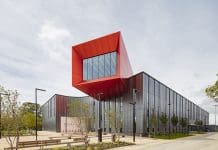Following the launch at London Build of a landmark publication for designers and architects, the Supply Chain Sustainability School has brought together expertise from across the community, to inform and inspire both current practitioners and the next generation of professionals
The Social Value and Design of the Built Environment document explores why social value in design matters, what trends are driving the agenda, where the key challenges lie and, ultimately, what designers themselves, both individually and collectively, can do as part of a strategy for conducting their business responsibly.
Whether designing homes, hospitals, workplaces, schools, shops or railway stations, social value matters. From mitigating impacts of austerity through affordability, to combatting ageism via accessibility, it is crucial to create inclusive, caring communities, for health, wealth and wellbeing.
Five years on from the Public Services (Social Value) Act 2012, its significance for projects in the built environment extends far beyond the procurement of public-sector services; it has changed client expectations of how construction, infrastructure, refurbishment, fit-out and facilities management projects should be delivered.
Designers and architects can generate social value by integrating people’s views into decision-making, supporting cultural integration and social cohesion, creating built-environment assets that promote health and wellbeing, and enhance lifespan and value, boosting economic prosperity.
Turning policy into practice, the report showcases an extensive gallery of case-studies across six prime built environment sectors: Infrastructure, Education, Housing, Health, Offices and Retail. The range of exemplars speaks to the diversity of applications of social value in design.
David Miller, Director and Principal Architect, David Miller Architects, said:
“Contractors have long been asked by public-sector clients to commit to delivering social value on their projects and it’s wholly appropriate that this is extended to other professions. Not only can we make a positive difference to the communities in which we work, but we can also help to address the skills shortage by inspiring others to take up rewarding careers in the built environment.”
Alison Ball, Sustainability Leader at Arup, suggests that people-centric thinking is crucial:
“As designers, we have a significant role to play; we can make a tangible difference by putting people at the heart of our approach in every element of our work in the built environment.”
In order to realise project potential, it is this willingness to prioritise a ‘social value thought-process’ that effectively represents the key design choice, adds Mark Sidding, Director, Watson Batty Architects, who supports the collaborative approach taken by the School towards mindset shift:
“The ability for designers to significantly influence positive social impact has never been in doubt, no matter the scale or scope of the project. The Supply Chain School have brought together a team of like-minded organisations to challenge current thinking, and launch an important publication which shares our aspirations to make a difference in our communities.”
Looking beyond initial briefs and build, the scope for positive impacts throughout the operational lifecycle is further highlighted by Dan Rennison, Group Head of Design Management, at Costain:
“Our ability to improve lives, not only those we interact with during the design and construct phase, but also during the significant time these smart infrastructure assets are in use should be embraced.”
Founding Director of the Supply Chain School, Ian Heptonstall, concluded:
“The phrase ‘social value’ is rapidly gaining currency and breadth in application. It is already core for many clients and contractors and time now for designers and architects to align their thinking with the construction value chain. This multi-stakeholder document seeks to forge that connection.”

















